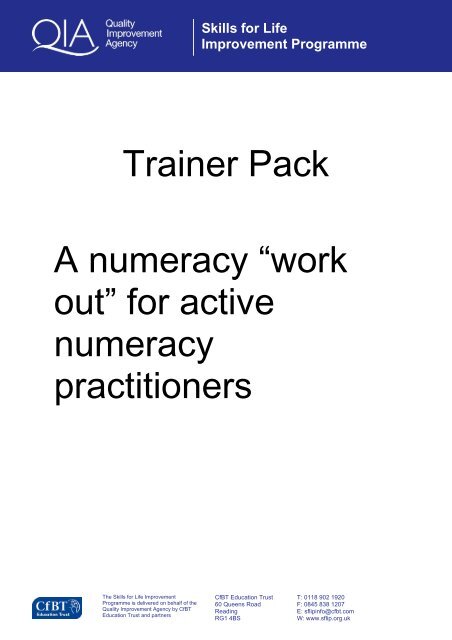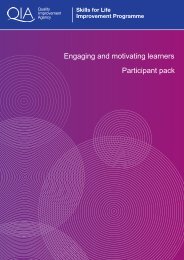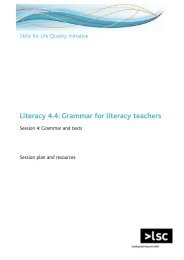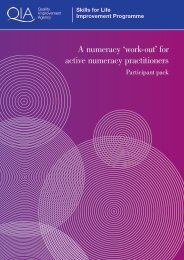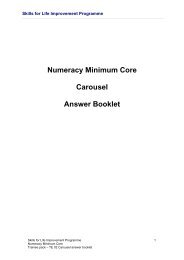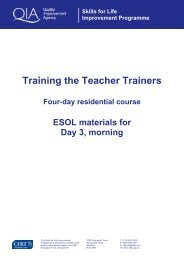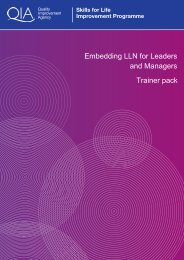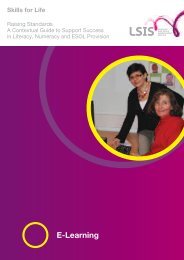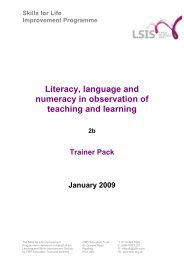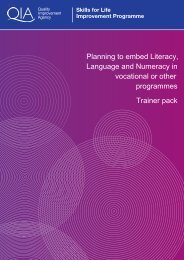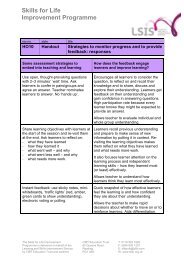Trainer Pack A numeracy - Excellence Gateway
Trainer Pack A numeracy - Excellence Gateway
Trainer Pack A numeracy - Excellence Gateway
You also want an ePaper? Increase the reach of your titles
YUMPU automatically turns print PDFs into web optimized ePapers that Google loves.
Skills for LifeImprovement Programme<strong>Trainer</strong> <strong>Pack</strong>A <strong>numeracy</strong> “workout” for active<strong>numeracy</strong>practitionersThe Skills for Life ImprovementProgramme is delivered on behalf of theQuality Improvement Agency by CfBTEducation Trust and partnersCfBT Education Trust60 Queens RoadReadingRG1 4BST: 0118 902 1920F: 0845 838 1207E: sflipinfo@cfbt.comW: www.sflip.org.uk
IntroductionThe Skills for Life Improvement Programme is new. It builds on previous initiatives,making best use of people, systems and materials to help deliver the Skills for Lifestrategy in the future. It is an innovative programme designed to support creativechange in a wide variety of self-improving organisations.The programme is delivered through three separate strands:• Strand 1 – Workforce Development• Strand 2 – A whole organisation approach to quality improvement• Strand 3 – Innovation in teaching and learningThe Skills for Life Improvement Programme is delivered by a consortium led by CfBT.It includes some of the key national agencies. These are:• CfBT Education Trust• Edexcel/ Pearson• Epic• General Federation of Trade Unions• LLU+ London South Bank University• Learning and Skills Network• National Foundation for Education Research• The National Institute of Adult Continuing Education• National Research and Development Centre• Skill: National Bureau for Students with Disabilities• The Network• University of WolverhamptonSkills for Life Improvement Programme 2A <strong>numeracy</strong> “workout” for active <strong>numeracy</strong> practitioners<strong>Trainer</strong> pack
A “<strong>numeracy</strong> work out” for active <strong>numeracy</strong> practitionersSkills for Life Improvement Programme 3A <strong>numeracy</strong> “workout” for active <strong>numeracy</strong> practitioners<strong>Trainer</strong> pack
Length of Session: One dayCourseInformationTarget GroupMode of Delivery: workshopLevel: Level 3 or 4Length of Self Study (if applicable) noneJob RoleCurrent practitionersSubject SpecialismNumeracySectorAll (FE, ACL, JCP, NHS, Prison, WBL, ETP, etc.)Course overview• The course provides an opportunity for you to become more energised inyour approach to teaching <strong>numeracy</strong>. There will be an opportunity toexplore your own skills as well as strategies for working with learnersthrough a series of engaging and interactive activities.RationaleWhat is the expected improvement in teaching and learning as a result of attendingthis course?• To be more skilled at and have a bigger range of strategies forapproaching <strong>numeracy</strong> teachingAims • For you to become more energised in your approach to teaching<strong>numeracy</strong>Outcomes • Know what makes a good <strong>numeracy</strong> tutor• Begin to evaluate your own current approaches to <strong>numeracy</strong>• Feel more confident about trying out and using new teaching approaches• Pick up some tips and strategies you can use immediately• Raised your awareness of your own confidence in maths• Explore how maths can help you in making choices and decisions in thereal world• Explore some of the current sources of ideas and materials for <strong>numeracy</strong>• Create a plan for the next stage in your development as a <strong>numeracy</strong> tutorThis coursemaps to theseprofessionalstandards:• The Subject Specifications for Teachers of Adult Literacy, ESOL andNumeracySkills for Life Improvement Programme 4A <strong>numeracy</strong> “workout” for active <strong>numeracy</strong> practitioners<strong>Trainer</strong> pack
A “<strong>numeracy</strong> work out” for <strong>numeracy</strong> practitionersEntry CriteriaTo be currently involved in <strong>numeracy</strong> teaching and/or support.How is the courseassessed?informal assessmentAccreditationNoneProgressionNot applicableDuring the session you will have the opportunity to:Course Overview• Examine the different factors in becoming a more effective<strong>numeracy</strong> tutor• Complete a self assessment of your current skills andapproaches• Develop your own mathematical skills and try out somedifferent strategiesNotes on equality ofopportunity andinclusivityThe session will use a methodology that seeks to beaccessible to all participants. In particular, activities will bedifferentiated to take into account different levels ofexperience and confidence in Maths.<strong>Trainer</strong> experience orCurrent or recent experience in delivering <strong>numeracy</strong> and/orqualifications requiredteacher training. A flair for energising participantsPre-course reading fortrainersNoneSkills for Life Improvement Programme 5A <strong>numeracy</strong> “workout” for active <strong>numeracy</strong> practitioners<strong>Trainer</strong> pack
ResourcesResources to beavailable fordelegates at thesessionPlease ensure that there are up to date resources and key documents availableOne set per venue: Standards unit Mathematics Subject Learning Coach box ofresourcesOne per venue: Malcolm Swan (2006) Collaborative Learning in Mathematics,NIACEOne per participant: Malcolm Swan (2006): Towards more active learningapproaches (NRDC)Any other resources/displays as NIACE and its partners can supply, e.g. adisplay of resources from NRDC and Maths4 LifeEquipmentrequiredFlipchartComputer facilities (including powerpoint)Internet connectionCardScissorsHole punchNon-permanent marker pens (dry wipe)Ball of stringDrawing pinsBlu-tackPost-it notesBlank pieces of card ¼ A4 sizeBox of tissuesPaperclipsPre-course activityfor participantsNoneSkills for Life Improvement Programme 6A <strong>numeracy</strong> “workout” for active <strong>numeracy</strong> practitioners<strong>Trainer</strong> pack
Useful Websites See Handout 9Reference material See handout 9Further reading Se Handout 9Session plan and Resources for: A <strong>numeracy</strong> “work out”for <strong>numeracy</strong> practitionersAimFor participants to:• become more energised in their approach to teaching <strong>numeracy</strong>Learning outcomesBy the end of the session, participants will have:• Identified what makes a good <strong>numeracy</strong> tutor• Begun to evaluate their own current approaches to <strong>numeracy</strong>• Tried out and used new teaching approaches• Picked up some tips and strategies to use immediately• Developed more confidence mathematically• Explored how maths can help in making choices and decisions in the real world• Explored some of the current sources of ideas and materials for <strong>numeracy</strong>• Created a plan for the next stage in their development as a <strong>numeracy</strong> tutorSkills for Life Improvement Programme 7A <strong>numeracy</strong> “workout” for active <strong>numeracy</strong> practitioners<strong>Trainer</strong> pack
Time09.30(10)ContentWelcome• Welcome, housekeeping,introductions• Introduce the main aims, thelearning objectives and the learningjourney we hope they will follow• Introduce the reflective log andencourage participants to use itthroughout the day• Inform participants that we will issuereminders throughout the day touse their reflective log and alsoinsert <strong>numeracy</strong> energiser activitiesany time we think they need a burstof extra stimulus• Set up and refer to an issues boardfor comments and an informationsharing board (for sources ofresources, research, information,etc.). Encourage participants to usepostit notes to add to these duringthe dayResourcesNo. Style TitlePowerpointdiskHP Powerpoint Handout of powerpoint slidesas handoutP1 Powerpoint Title slideP2 Powerpoint Aim of the sessionP3 Powerpoint Learning objectivesP4 Powerpoint Format for the dayH1 Handout 1 ProgrammeH2 Handout 2 Learning journeyH3 Handout 3 Reflective log09.40Skills for Life ImprovementProgrammeP5PowerpointPurpose: to introduce the SfLIP andupdate participants on SfL strategy• Talk participants throughpowerpoint presentation• Ensure this is interactive by elicitingas much information from thedelegates(20)Skills for Life Improvement Programme 8A <strong>numeracy</strong> “workout” for active <strong>numeracy</strong> practitioners<strong>Trainer</strong> pack
10.30(30 min)Activity 3: Setting <strong>numeracy</strong> ina wider contextPurpose: to give participants practice inthinking of <strong>numeracy</strong> activities in differentcontexts• Introduce the activity as “ready,steady let’s cook up some<strong>numeracy</strong>”, like the TV programme• Each table has a plastic bagcontaining real life items brought inby trainers to stimulate thinking• Participants work in pairs and selectan item (which may include the bagitself)P9H5PowerpointPlastic bagof realresourcesbrought inby trainers– one pertableHandout 5Ready Steady Cook• They devise as many different<strong>numeracy</strong> activities as they can, atdifferent levels, for different types oflearner, for both groups andindividuals and reflecting each ofthe 3 different spheres of influenceFlip chartpaper andpens(90)• They record findings as a poster onflipchart paper the activities theydevised and prepare to feedbackany issues11.00 Coffee break11.20Feedback on Activity 3(30 min)Purpose: to share practice in thinking of<strong>numeracy</strong> activities in different contexts• Circulate to look at flipchart posters• Depending on the number ofparticipants, do feedback to fullgroup, or in clusters around theposters, where participants choosewhich ones to concentrate on.• Plenary discussion of issuesemerging. N.B. comment on theuse of making posters as alearning/thinking activity in<strong>numeracy</strong>(120)• Use reflective log to record any newideas11.50(40 min)Activity 4: Adopting a problemsolving approachPurpose: to encourage participants to thinkcreatively and problem solve <strong>numeracy</strong>issuesP10Powerpoint• Introduce the idea of working moreopen endedly with <strong>numeracy</strong>Skills for Life Improvement Programme 10A <strong>numeracy</strong> “workout” for active <strong>numeracy</strong> practitioners<strong>Trainer</strong> pack
open-endedly with <strong>numeracy</strong>learners• Direct participants to the envelopeof problem solving cards in theirpack. Ask them to sort cards into:ALWAYS TRUESOMETIMES TRUENEVER TRUER2Resource 2Problem solving cards inenvelopes• If time, ask participants to writestatements on the blank cards,which are always, sometimes ornever trueH6Handout 6Ordering probabilities• Reflect on how they might use thistechnique with learners• Introduce the Ordering Probabilitiesactivity• One trainer sets up string and cardsaccording to instructions, while thesecond trainer provides acommentaryR3String,drawingpins, etc.Resource 3Probability cards• Follow the instructions on Handout6 for cards with words on• Encourage participants to completestatements on blank cards andplace them on the probability string• Place cards with different sizes ofdecimal numbers on the samestring, encouraging participants tojoin in(150)• Discuss how the good thing aboutthis approach is that it illustratesand explains rather abstractconcepts in a tangible interactiveway. Think about what otherconcepts you could explain usingthis approach.• Participants complete reflective logfor how they might use this activitywith learners.12.30(15 min)Activity 5: Exploring resourcesPurpose: to gain information aboutresources availableP11Powerpoint• Look at a sample of materials onwebsites. <strong>Trainer</strong>s showcase anywebsites they particularly like onscreen.Leave the computer onover lunch time for participants toexplore more• Participants browse availableresources(175)• Opportunity to add to reflective logbefore lunchH3Handout 3Reflective logSkills for Life Improvement Programme 11A <strong>numeracy</strong> “workout” for active <strong>numeracy</strong> practitioners<strong>Trainer</strong> pack
12.45 LUNCH13.30(15 min)Energiser slotPurpose: to raise stimulus levels and alsoillustrate the impact of short activities in a<strong>numeracy</strong> context• Developed by individual trainers attraining the trainer’ dayResourcespreparedby eachtrainer• N.B. keep an eye on the time, allowtime for a de-brief.(190)• Be aware of the levels ofconfidence of your participants inhandling the activity(NB these will mainly be oral activities,so no stylistic requirements!)13.45(30 min)Activity 6: Making the most oflanguagePurpose: to explore the importance oflanguage to <strong>numeracy</strong>• Introduce the fact that we are justgoing to explore one aspect of thelanguage of Maths – how to makeinformation in text form moreaccessible to learnersP12H7PowerpointHandout 7DARTS• Demonstrate the approach with apiece of text on powerpoint. Ask forpreparatory prompts before alearner begins to solve the problem,which is taken from a Level 2practice testP13Powerpoint• Explain the concept of DARTS• Give out handout 8 on DARTSactivity.• Participants discuss the openingpages on their tables• Participants complete the activity inpairs by thinking up some DARTSprompts• There is a selection of suggestedDARTS prompts on the final page(ask participants to look at theseonly after they have worked onsome ideas of their own).(220)• Point out to participants that theactual scenario for painting anddecorating reflects a professionaldoing a proper estimate for costingmore than DIYSkills for Life Improvement Programme 12A <strong>numeracy</strong> “workout” for active <strong>numeracy</strong> practitioners<strong>Trainer</strong> pack
Put in another energiser here ifneeded14.15(30 min)Activity 7: Use of activequestioningPurpose: to try out a range of questioningtechniques and use of mini white boards• Show Handout 8 on the use of miniwhite boards and “show me”questions• Use 2 nd half of Handout 8 to ask aseries of show me questions.Participants answer using miniwhite boards• Reflect on how you would use theseP14H8R4PowerpointHandout 8Resource 4Nonpermanentmarkers,papertowelsUsing mini white boardsMini white board (laminated)(250)• Do a card matching activity with thequestioning cards (N.B. these areno longer set up as dominos, morematching the pairs) Facilitatediscussion about questioning skillsand signpost participants to othersources of training/information ifthey want to know moreR5Resource 5Questioning cards14.45(15min)Activity 8: Contacts for furthersupport and trainingPurpose: to share information on sources ofbest practice• Give out handout 9 on sources ofinformationP15H9PowerpointHandout 9Numeracy Headlines(265)• Participants encouraged to shareand add local contacts from theinformation boards15.00(30 min)Action Plan, questions andevaluationPurpose: to enable participants to plan forhow they will apply what they have learnedtodayP16Powerpoint• Participants encouraged tocomplete their reflective log toinclude the action plan on thesecond pageH3Handout 3Reflective log• Refer back to Handout 4 (whatmakes a good <strong>numeracy</strong> tutor) andsee if they would change theirpersonal profile as a result oftoday’s trainingH4• Plenary discussion of this and anyother topics• Refer back to learning objectives forthe day and check on coverageP17PowerpointSkills for Life Improvement Programme 13A <strong>numeracy</strong> “workout” for active <strong>numeracy</strong> practitioners<strong>Trainer</strong> pack
(295) • Complete evaluations P1815.30 Tea and closeCfBTEvaluationSkills for Life Improvement Programme 14A <strong>numeracy</strong> “workout” for active <strong>numeracy</strong> practitioners<strong>Trainer</strong> pack
P1- 18HPH1H2H3H4H5H6H7H8H9R1R2R3R4R5PowerpointHandoutHandoutHandoutHandoutHandoutHandoutHandoutHandoutHandoutHandoutResourceResourceResourceResourceResourcePowerpoint (on Disk)Handout of Powerpoint slides (3 to a page)ProgrammeLearning JourneyReflective LogWhat makes a good <strong>numeracy</strong> tutorReady Steady CookOrdering ProbabilitiesDARTSUsing Mini white boardsNumeracy headlinesNumeracy stories (cut into cards – 2 sets pertrainer)Problem cards (cut into cards and put inenvelopes) (one set per trainer pack andparticipant pack)Probability cards (cut into ¼ A4 including someblank cards and with a hole punched in the topmiddle. Please make each page a differentcolour of card) (one set per trainer pack andparticipant pack)A4 Mini white board (laminated) (one pertrainer and per participant)Questioning cards (cut into cards and put inenvelope) (one set per trainer pack andparticipant pack)Skills for Life Improvement Programme 15A <strong>numeracy</strong> “workout” for active <strong>numeracy</strong> practitioners<strong>Trainer</strong> pack
Skills for Life Improvement Programme 16A <strong>numeracy</strong> “workout” for active <strong>numeracy</strong> practitioners<strong>Trainer</strong> pack


